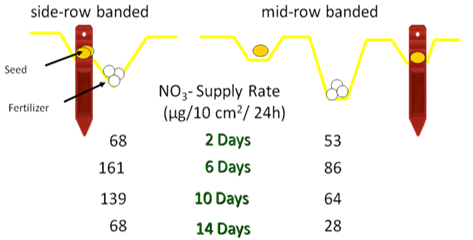Research Applications
Many economic concerns involving low crop prices and high cost of fertilizer, as well as environmental issues such as leaching and gaseous losses to the atmosphere, are driving attempts to increase the efficiency and efficacy of fertilizers. PRS® Probes have also been used in various studies to determine spatial and temporal variations in fertilizer nutrient bio-availability.
Examples
-
Evaluation of a sprayable elemental sulfur fertilizer under field conditions in Alberta. Elemental sulfur fertilizers have a poor reputation due to slow oxidation when applied as large or poorly distributed particles. A micronized elemental sulfur product that is sprayed on the soil surface, Sulgro 70 (Sultech, Calgary, AB), avoids these issues and thus has the potential to be rapidly oxidized. In a recently accepted paper in the Canadian Journal of Soil Science, Plant Root Simulator (PRS®) probes were used to demonstrate that Sulgro 70 consistently increased soil S supply within 4 weeks of seeding, even under dry conditions. By 4 to 8 weeks after seeding, Sulgro 70 was on average 54% as effective at increasing soil S supply as ammonium sulfate. PRS® probes were useful to determine the efficacy of Sulgro 70 under field conditions.
- Early supplies of available nitrogen to the seed-row of a canola crop as affected by fertilizer placement. Thavarajah et. al. (2003) has used PRS® Probes to measure soil N and P supply rates as affected by fertilizer placement and type. Results showed that urea side-row band treatments had earlier and greater available N supply rates than mid-row band placement, but no significant differences were observed in P supply rates.

- Effectiveness of an elemental sulfur fertilizer in an oilseed-cereal-legume rotation on the Canadian prairies.
- Effect of long-term fertilization and placement of phosphorus on barley yields.
- Sulphur fertilizer and tillage effects on early season sulphur availability and N:S ratio in canola in western Canada.
- Spatial distribution and chemical speciation of soil phosphorus in a band application.
- Nitrate leaching potential under variable and uniform nitrogen fertilizer management in irrigated potato systems.
